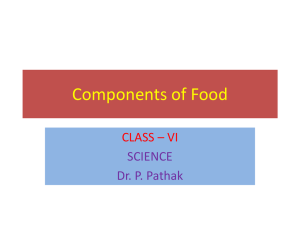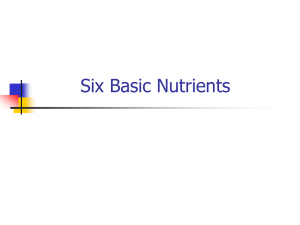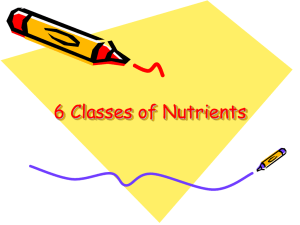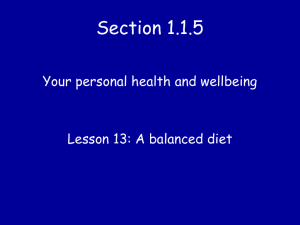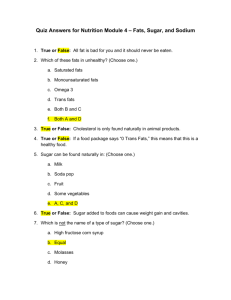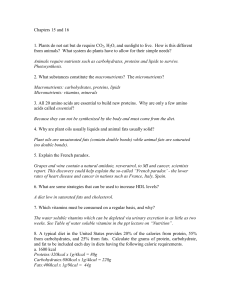2. Nutrients and their Sources Word version
advertisement
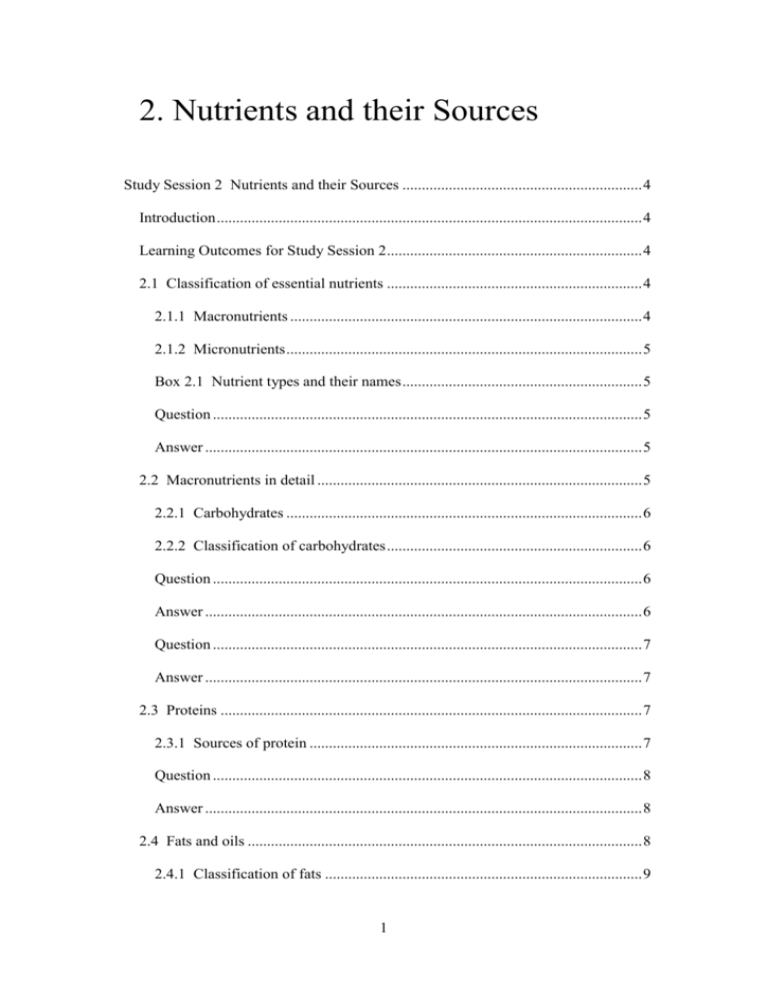
2. Nutrients and their Sources Study Session 2 Nutrients and their Sources .............................................................. 4 Introduction .............................................................................................................. 4 Learning Outcomes for Study Session 2 .................................................................. 4 2.1 Classification of essential nutrients .................................................................. 4 2.1.1 Macronutrients ........................................................................................... 4 2.1.2 Micronutrients ............................................................................................ 5 Box 2.1 Nutrient types and their names .............................................................. 5 Question ............................................................................................................... 5 Answer ................................................................................................................. 5 2.2 Macronutrients in detail .................................................................................... 5 2.2.1 Carbohydrates ............................................................................................ 6 2.2.2 Classification of carbohydrates .................................................................. 6 Question ............................................................................................................... 6 Answer ................................................................................................................. 6 Question ............................................................................................................... 7 Answer ................................................................................................................. 7 2.3 Proteins ............................................................................................................. 7 2.3.1 Sources of protein ...................................................................................... 7 Question ............................................................................................................... 8 Answer ................................................................................................................. 8 2.4 Fats and oils ...................................................................................................... 8 2.4.1 Classification of fats .................................................................................. 9 1 Question ............................................................................................................... 9 Answer ................................................................................................................. 9 2.5 Water ................................................................................................................. 9 2.6 Fibre ................................................................................................................ 10 2.6 Including fibre in the diet ............................................................................ 10 2.7 Micronutrients in detail ................................................................................... 10 2.7.1 Vitamins ................................................................................................... 10 2.7.2 Minerals ................................................................................................... 12 Question ............................................................................................................. 13 Answer ............................................................................................................... 13 2.8 A balanced diet ............................................................................................... 13 2.8.1 Helping families to have good balanced diet ........................................... 14 2.8.2 The mixture of foods to use ..................................................................... 15 2.8.3 Adding other foods to the staple food ...................................................... 15 Question ............................................................................................................. 16 Answer ............................................................................................................... 16 Summary of Study Session 2 ................................................................................. 16 Self-Assessment Questions (SAQs) for Study Session 2 ...................................... 17 SAQ 2.1 (tests Learning Outcomes 2.1, 2.2 and 2.3) ........................................ 17 Answer ............................................................................................................... 17 SAQ 2.2 (tests Learning Outcomes 2.3, 2.4 and 2.5) ........................................ 17 Answer ............................................................................................................... 18 SAQ 2.3 (tests Learning Outcome 2.6) .............................................................. 18 Answer ............................................................................................................... 18 2 3 Study Session 2 Nutrients and their Sources Introduction In the previous session you learned about nutrition, nutrients, food and food choices. In this session, you will learn about each nutrient in more detail. You will learn about the major categories of nutrients, the main sources of these, their function, and how our body uses each of these nutrients for healthy growth and development. There are seven main classes of nutrients that the body needs. These are carbohydrates, proteins, fats, vitamins, minerals, fibre and water. It is important that everyone consumes these seven nutrients on a daily basis to help them build their bodies and maintain their health. Deficiencies, excesses and imbalances in diet can produce negative impacts on health, which may lead to diseases. This study session will help you to explain to families and individuals in your community the importance of consuming a healthy and balanced diet, and how to do this with the resources available to them. Learning Outcomes for Study Session 2 When you have studied this session, you should be able to: 2.1 Define and use correctly all of the key words printed in bold. (SAQ 2.1) 2.2 Classify foods into groups according to their nutrients and differentiate between macronutrients and micronutrients. (SAQ 2.1) 2.3 List the sources and functions of the nutrients. (SAQs 2.1 and 2.3) 2.4 Describe vitamins and their classification. (SAQ 2.2) 2.5 Explain the functions of the common minerals that people require in their diet. (SAQ 2.2) 2.6 Describe a balanced diet for people in your community. (SAQ 2.3) 2.1 Classification of essential nutrients Based on the amount of the nutrients that each person needs to consume on a daily basis, these nutrients are categorised into two groups. These are macronutrients, which should be consumed in fairly large amounts, and micronutrients, which are only required in small amounts. 2.1.1 Macronutrients 4 ‘Macro’ means large; as their name suggests these are nutrients which people need to eat regularly and in a fairly large amount. They include carbohydrates, fats, proteins, fibre and water. These substances are needed for the supply of energy and growth, for metabolism and other body functions. Metabolism means the process involved in the generation of energy and all the ‘building blocks’ required to maintain the body and its functions. Macronutrients provide a lot of calories but the amount of calories provided varies, depending on the food source. For example, each gram of carbohydrate or protein provides four calories, while fat provides nine calories for each gram. 2.1.2 Micronutrients As their name indicates (‘micro’ means small) micronutrients are substances which people need in their diet in only small amounts. These include minerals and vitamins. Although most foods are mixtures of nutrients, many of them contain a lot of one nutrient and a little of the other nutrients. Foods are often grouped according to the nutrient that they contain in abundance (see Box 2.1). Box 2.1 Nutrient types and their names Foods that contain a lot of protein are called body-building foods or growing foods. Foods that contain a lot of fat or carbohydrates and perhaps only a little protein are called energy-giving foods. Foods in which the most important nutrients are vitamins or minerals are called protective foods. Question What are some of the common foods consumed in your community? Make a list in your Study Diary. Answer You might have included some of the following in your list; ‘injera’, maize, ‘kocho’, bread, porridge (‘genfo’), egg, meat, butter, ‘shiro’, ‘kitta’, milk, cheese, yogurt, different types of fruits, sugar cane, cabbage, lettuce, lentils, nuts, beans, fish, chicken, fish, oils, and breastmilk. End of answer If people are to stay healthy they must eat a mixed diet of different foods which contain the right amount of nutrients. 2.2 Macronutrients in detail 5 You are now going to look at the different macronutrients in more detail. 2.2.1 Carbohydrates Carbohydrates are referred to as energy-giving foods. They provide energy in the form of calories that the body needs to be able to work, and to support other functions. Carbohydrates are needed in large amounts by the body. Indeed, up to 65% of our energy comes from carbohydrates. They are the body’s main source of fuel because they are easily converted into energy. This energy is usually in the form of glucose, which all tissues and cells in our bodies readily use. For the brain, kidneys, central nervous system and muscles to function properly, they need carbohydrates. These carbohydrates are usually stored in the muscles and the liver, where they are later used for energy. The main sources of carbohydrates are bread, wheat, potatoes of all kinds, maize, rice, cassava, ‘shiro’, pasta, macaroni, ‘kocho’, banana, sweets, sugar cane, sweet fruits, and honey. Other foods like vegetables, beans, nuts and seeds contain carbohydrates, but in lesser amounts. 2.2.2 Classification of carbohydrates Based on the number of sugar units, carbohydrates are classified into three groups; these are monosaccharides, disaccharides and polysaccharides. You need to know the classes of carbohydrates to enable you to give relevant advice to patients with special needs like diabetes (when someone has problems regulating the amounts of glucose in their body). Monosaccharides and disaccharides are referred to as simple sugars or simple carbohydrates that our body can easily utilise. For this reason, people with diabetes mellitus shouldn’t eat too many of these carbohydrates. Examples include sugar, honey, sweet fruits and sugar cane. Polysaccharides are called complex carbohydrates and they need to be broken down into simple sugars to be used by our body. They can be consumed by diabetic patients without restriction. Examples include starch and cellulose. Question Can you think of examples of foods that are sources of carbohydrate? Answer Bread, ‘teff’, maize, ‘kocho’, potatoes, sugar cane, honey, sweet fruits, pasta, macaroni and ‘shiro’ are good sources of carbohydrates. End of answer 6 Question Which of these foods are simple sugars and should not be eaten in large quantities by patients who have diabetes? Answer Sugar cane, honey, sweet fruits and biscuits are among the food groups that shouldn’t be consumed by patients with diabetes. End of answer 2.3 Proteins About 10–35% of calories should come from protein. Proteins are needed in our diets for growth (especially important for children, teens and pregnant women) and to improve immune functions. They also play an important role in making essential hormones and enzymes, in tissue repair, preserving lean muscle mass, and supplying energy in times when carbohydrates are not available. Pregnant women need protein to build their bodies and that of the babies and placentas, to make extra blood and for fat storage. Breastfeeding mothers need protein to make breastmilk. 2.3.1 Sources of protein The main sources of proteins are meats, chicken, eggs, breastmilk, beans, ground nuts, lentils, fish, cheese and milk. All animal foods contain more protein than plants and are therefore usually better sources of body building foods. However, even though plant proteins (see Figure 2.1) are usually not as good for body-building as animal proteins, they can become more effective nutritionally when both are mixed with each other. 7 Figure 2.1 Meat is a good source of protein. (Photo: Dr Basiro Davey) Question Look again at the list of foods you wrote in Section 2.1.2. Which of these foods are sources of protein? Which of these food groups have good quality protein? Answer Beans, nuts, lentils, breastmilk, meat, egg, chicken, cheese and milk are sources of protein. Really good quality protein can be found in animal sources such as breastmilk, meat, eggs, chicken, cheese and milk. End of answer 2.4 Fats and oils 8 Fats and oils are concentrated sources of energy and so are important nutrients for young children who need a lot of energy-rich food. Fats can also make meals more tasty and satisfying. Fat is found in meat, chicken, milk products, butters, creams, avocado, cooking oils and fats, cheese, fish and ground nuts. 2.4.1 Classification of fats Fats are classified into saturated and unsaturated fats. The classification is important to enable you to advise your community about which fats can be consumed with less risk to people’s health. Saturated fats are not good for a person’s health. Saturated fats are usually solid at cool temperatures. Eating too much saturated fat is not good for a person’s health, as it can cause heart and blood vessel problems. Unsaturated fats are usually liquid at room temperature. These types of fats are healthy fats. Examples include fats from fish, oil seeds (sesame and sunflower), maize oil and ground nut oil and breastmilk. As a general rule, plant sources of fats are better for a person’s health than the animal sources, because animal fats contain more saturated fats. Question Look at the list of foods you wrote in Section 2.1.2. Which of these foods are sources of fats? Which of these fats are not healthy fats? Answer Cooking oils, butter, meat, chicken, fish, ground nut oils and breastmilk are among the sources of fats. Butter, meat fats and oils from animal sources are not good fats, because they have a high amount of saturated fats. End of answer 2.5 Water You may remember from Study Session 1 that a 50 kg adult contains about 31 litres of water and a one year old, 10 kg child contains nearly 8 litres of water. Almost every part of the body contains large amounts of water. People can live without solid food for a few weeks, but we cannot live without water for more than a few days. An adult needs about 2–3 litres of water each day. That is why giving drinks are so important when people lose a lot of water, such as when they have diarrhoea. Water is essential for life. We need water for a number of reasons: 9 For the body to make cells and fluids such as tears, digestive juices and breastmilk For the body to make sweat for cooling itself For essential body processes — most take place in water For keeping the lining of the mouth, intestine, eyelids and lungs wet and healthy For the production of urine, which carries waste from the body. 2.6 Fibre Fibre is a mixture of different carbohydrates which are not digested like other nutrients but pass through the gut nearly unchanged. Foods rich in fibre are ‘kocho’; vegetables like cabbage, ‘kosta’, carrots, cassava; fruits like banana and avocado; peas and beans; whole-grain cereals like wheat flour and refined maize or sorghum. 2.6 Including fibre in the diet Fibre should be included in the diet for the following reasons: Fibre makes food bulky or bigger — this can help a person who is overweight to eat less food Fibre makes the faeces soft and bulky; this can help prevent constipation Fibre slows the absorption of nutrients, so it helps nutrients to enter the blood stream slowly. This is important for patients with diabetes mellitus. In this section you have learned about the macronutrients: carbohydrates, fats, proteins, water and fibre, and how they nourish the body. You are now going to learn more about vitamins and minerals, the important micronutrients. 2.7 Micronutrients in detail 2.7.1 Vitamins Vitamins are groups of related substances present in small amounts in foodstuffs and are necessary for the body to function normally. Vitamins are also called protective foods. They are grouped together because, as their name implies, they are a vital factor in the diet. Classifications of vitamins Vitamins are classified into two groups: Fat soluble vitamins (vitamins A, D, E and K) are soluble in fats and fat solvents. They are insoluble in water. So these are utilised only if there is enough fat in the body. Water soluble vitamins (vitamins B and C, and folic acid) are soluble in water and so they cannot be stored in the body. 10 The best sources of micronutrients in our diets are fruits and vegetables. These two food groups contain essential vitamins and minerals. Animal sources of foods are also both good sources of micronutrients. However, an adequate micronutrient intake can only be achieved through sufficient intake of a balanced diet that includes plenty of fruits and vegetables. Table 2.1 overleaf sets out the functions of some of the important vitamins and examples of sources of food for each of these. Table 2.1 Functions and sources of vitamins. Vitamins Function Food sources Breastmilk, tomatoes, cabbage, lettuce, pumpkins Night vision Vitamin A Healing epithelial cells Mangoes, papaya, carrots Normal development of teeth and bones Liver, kidney, egg yolk, milk, butter, cheese cream Ultra violet light from the sun Vitamin D Needed for absorption of calcium from small intestines Calcification of the skeleton Eggs, butter, fish Fortified oils, fats and cereals Green leafy vegetables Vitamin K For blood clotting Fruits, cereals, meat, dairy products Milk, egg yolk, liver, kidney and heart Metabolism of B complex carbohydrates, proteins and fats Vitamin C Prevention of scurvy Whole grain cereals, meat, whole bread, fish, bananas Fresh fruits (oranges, banana, mango, grapefruits, lemons, potatoes) and vegetables 11 Vitamins Function Aiding wound healing Food sources (cabbage, carrots, pepper, tomatoes) Assisting absorption of iron Breastmilk Epithelial cells form the thin layer of tissue lining the gut, respiratory and genitourinary systems. Calcification refers to the hardening of bones by calcium deposits. Scurvy is a disease caused by vitamin C deficiency which leads to sore skin, bleeding gums and internal bleeding. 2.7.2 Minerals Minerals are the substances that people need to ensure the health and correct working of their soft tissues, fluids and their skeleton. Examples of minerals include calcium, iron, iodine, fluorine, phosphorus, potassium, zinc, selenium, and sodium. Table 2.2 outlines the functions of some of these important minerals and examples of sources of food for each of these. Table 2.2 Functions and sources of common minerals. Minerals Calcium Function Food sources Milk, cheese and dairy products Gives bones and teeth rigidity and strength Foods fortified with calcium, e.g. flour, cereals. eggs, fish cabbage Meat and meat products Iron Formation of haemoglobin Eggs, bread, green leafy vegetables, pulses, fruits Iodised salt, sea vegetables, yogurt, cow's milk, eggs, and cheese Iodine For normal metabolism of cells Fish; plants grown in iodine-rich soil 12 Minerals Function For children to grow and develop Zinc normally; for wound healing Fluorine Helps to keep teeth strong Food sources Maize, fish, breastmilk, meat, beans Water Question What are the main sources of micronutrients and why are they important as part of a healthy diet? Answer Fruits and vegetables are the main sources of micronutrients. Animal foods also have micronutrients. The vitamins and minerals that make up micronutrients have a crucial role in enabling the body to function properly. Your role as a Health Extension Practitioner is to advise people in your community to have a balanced diet that includes micronutrients. End of answer You will learn more about micronutrients in Study Session 7, in particular the impact of deficiencies in vitamin A, iron and iodine on individuals and communities. 2.8 A balanced diet You have already come across the term ‘balanced diet’ several times in this Module. In this section we’ll discuss what a balanced diet is and the benefits of a balanced diet. It is important that you know enough to be able to recommend a balanced diet for the people in your community. Eating a balanced diet means choosing a wide variety of foods and drinks from all the food groups. It also means eating certain things in small amounts, namely saturated fat, cholesterol, simple sugar, salt and alcohol. The goal is to take in all of the nutrients you need for health at the recommended levels and perhaps restrict those things that are not good for the body. Figure 2.2 shows you some good sources of micronutrients in a selection of food at a market. 13 Figure 2.2 Good sources of micronutrients (Photo: Dr Basiro Davey) To know if the diet is balanced and to plan a balanced diet you have to think about two things: the mixture of foods and the amount of food a person eats. 2.8.1 Helping families to have good balanced diet The best way to help individuals in your community prepare a balanced diet is to learn which foods people use, the amount of different foods available, and how they prepare their meals. Then you can decide if people need help or further support or information to improve the balance of things they eat. Fat and added sugars come mostly from fats, oils and sweets, but can be part of or added to food from the other food groups as well. Figure 2.3 shows a food pyramid. It helps us identify the food groups people should combine in order to make a balanced diet. The food groups at the top of the pyramid should be eaten in moderation (small amount) but food groups at the bottom of the pyramid should be eaten in larger amounts. 14 Figure 2.3 Food pyramid 2.8.2 The mixture of foods to use The staple food is the common type of food that is consumed by the community. It should be part of a balanced diet because it’s the main part of most meals. The staple diet may vary from region to region. For example, ‘injera’ is the staple diet in many sites, maize in other areas, and ‘kocho’ in the southern part of the country. These foods are usually cheap, and provide most of the energy, protein and fibre in a meal, as well as some vitamins. 2.8.3 Adding other foods to the staple food In order to have a good balanced diet, people in your community will need to eat other foods in addition to the staple foods. The additional foods are important because they: Provide nutrients that may not be available in the staple food. For example, legumes such as peas, beans and lentils add protein, iron and other minerals and fat; green and yellow vegetables and fruits add vitamins A and C, folate, and fibre Make the food less bulky Make the diet more tasty and interesting to eat. 15 A diet which is composed of staples, legumes and vegetables or fruits is a good, balanced diet because this combination of foods will provide most of the nutrients that the people in your community need. The problem with the diet above is a lack of animal sources of food. Animal sources are good because they contain plenty of protein, have high energy (due to the fats), and the iron is easily absorbed compared with the iron sourced from plants. Therefore adding small amounts of animal products like meat, milk and eggs to staples, legumes and vegetables will improve the balanced diet. As well as protein, animal foods will also provide fat (for energy) and vitamins (especially vitamin A and folate), iron and zinc. But these foods may not be easily available and even if they are, they are usually expensive. Question Think about the types of foods usually consumed by your community and write a list of two groups of balanced diets, one with presence of animal foods and the other without animal foods. Answer If you are creating a diet that includes animal products ‘kocho’ may be the staple food and this could be eaten with fried meat/fried eggs, cabbage and tomatoes. You could create a balanced diet by mixing ‘injera’ (as a staple food), stew (‘wot’) made of beans/lentils, oil, ‘shiro’ and cabbage. End of answer Summary of Study Session 2 In Study Session 2 you have learned that: 1. Carbohydrates, proteins, fats, vitamins, minerals, water and fibre are the main groups of nutrients which together, but in variable amounts, make up a balanced diet. 2. Nutrients are grouped into macronutrients and micronutrients. Carbohydrates, proteins, fats and water are macronutrients, and vitamins and minerals are micronutrients. 3. Although most foods are mixtures of nutrients, many of them contain a lot of one nutrient and a little of the other nutrients. Foods are often grouped according to the nutrient that they contain in abundance. 4. Unsaturated fats are healthy fats; saturated fats are unhealthy fats. Therefore people in your community need to eat more of the unsaturated fats and try to reduce their intake of saturated fats. 5. Vitamins are substances present in small amounts in foodstuffs and are necessary for the body to function normally. Vitamins are also called protective foods. 6. Minerals have a number of functions in the body including developing body tissues and supporting metabolic processes. The minerals that are of most importance are calcium, iron, iodine, zinc and fluorine. 16 7. In order to have a healthy life and good nutritional status, a person needs to eat a balanced diet. You need to know the commonly used food groups in order to advise the people in your community on how to have a balanced diet. Self-Assessment Questions (SAQs) for Study Session 2 Now that you have completed this study session, you can assess how well you have achieved its Learning Outcomes by answering these questions. Write your answers in your Study Diary and discuss them with your Tutor at the next Study Support Meeting. You can check your answers with the Notes on the Self-Assessment Questions at the end of this Module. SAQ 2.1 (tests Learning Outcomes 2.1, 2.2 and 2.3) For the following nutrients, can you say why they are important and name one source? Are these foods micronutrients or macronutrients? Carbohydrates Proteins Fats and oils. Answer Carbohydrates provide energy. They are found in many foods including bread, potatoes, maize and bananas. Proteins are important for growth. They are found in meat, dairy products, fish and nuts. Fat is important for energy. It is found in meat and dairy products, avocados, oils and nuts. They are all macronutrients. End of answer SAQ 2.2 (tests Learning Outcomes 2.3, 2.4 and 2.5) Here are some questions members of your community might ask you. What answers would you give? 1. A woman asks you which is better for her family; animal fats or fish and vegetable oils? 2. A child is brought to the health centre with diarrhoea. What is the most important advice to give the mother? 17 3. A man complains of constipation. What foods should you tell him to include in his diet? 4. A young boy has a wound which is not healing. You need to make sure that his diet includes enough of one particular vitamin. Which vitamin is this and what foods will provide it? 5. A mother says that her child doesn’t like dairy products. Does this matter? Give reasons for your answer. Answer 1. Fish and vegetable oils are better than animal fats, which are saturated fats. 2. The child with diarrhoea needs to drink lots of water. 3. The man needs to include fibre in his diet (e.g. cabbage, avocado, bananas, legumes and cereals), as this will help to deal with his constipation. 4. Vitamin C, which can be found in fresh fruit, is particularly important for helping to heal wounds. 5. Because dairy products provide calcium which is necessary for strong bones and teeth it is important that children have a sufficient amount in their diet. (Although some other foods also contain some calcium.) End of answer SAQ 2.3 (tests Learning Outcome 2.6) How important is it to include animal sources of food in a diet? Answer Animal sources of food are an important part of a balanced diet because they add proteins, fat and vitamins to a diet. In particular, iron is more easily absorbed from an animal than a plant source. However, very little meat is needed, and if food like beans, nuts and dairy products are included in the diet then a family can have a balanced diet, without including meat. End of answer 18
